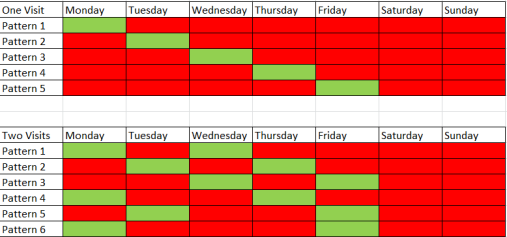
The visits should be planned for a week in advance. Hereby, a list of orders is specified whereby each location is visited at least once a week (one or more visits can be assigned to an order). All visits of a certain order have the same location and follow specified weekday patterns (for example in case of two visits Monday-Wednesday or Tuesday-Friday). Each cluster corresponds to exactly one working day, and every visit is assigned to exactly one cluster. Therefore, a maximum of 7 days of the week can be scheduled.
The orders are to be defined to plan clusters per weekday according to the specified conditions. The order has following primary settings:
Set unique order id
Set location
Set fixed order value to true or false (existing input plan: Yes or no)
Set number of visits per order
Set assignment rules
Set number of visits within one weekday by splitting the visits
In order to specify the week orders following attributes have to be taken into account:
| Attribute | Description |
|---|---|
| Validity of the week | Describes the valid weekdays within a week, for example Monday corresponds to day1, Tuesday corresponds to day2 etc. Only the first weekdayCount-days are considered at all. |

|
|
| Combination of Patterns | Add weekday patterns within one week. Set exemplarily Monday-Wednesday or Tuesday-Thursday patterns which describe the weekday patterns of a two visit order. Please notice every permitted combination of weekday patterns must be defined. Otherwise an exception occurs. The number of valid days in one pattern must correspond to the maximum visits per week. There are up to 35 weekday patterns per order possible. The next both figures exemplarily illustrate the permitted weekday patterns of one and two visits. |

|
|
| Rules of the week | Describes all rules and restrictions to assign every visit of the order to exactly one weekday. Following attributes are configurable: visits per week (mandatory), validities of the week (optional) and patterns of the weekday (maximum combinations is 35; mandatory) |
Following parameters are relevant to plan week orders:
| Attribute | Description |
|---|---|
| weekdayCount | The number of weekdays in the planning period (1 <= x <= 7). |
| regionCount | The number of regions per weekday (2 <= x <= 5, optional). |
| Weights | The weight per weekday to control the distribution (optional). The sum of all weights is the basis to calculate the distribution by percentage. For example, all weekdays with weight 100 and one weekday with weight 50 means the half of the quantity for that weekday compared to the others. The weight 0 indicates a fixed weekday. |
| visitsSplitsFactor | The factor to modify the quantities of a visit in case of splitting it into parts (>= 1, optional). As all parts of a visit are always assigned to one cluster, this factor should compensate the increased effort to visit the parts. A factor > 1 considers the additional driving period. So this is only reasonable in case of quantities standing for service periods. Omitting the attribute means no modification of the quantities. |
The operation plans the visits for one week whereby an amount of orders is already defined. Thereby, an order contains one or more visits within that week and all visits of an order have the same location following specified weekday patterns. The cluster optimization groups these visits into the given weekdays assigning every visit to exactly one weekday. The following output is performed after calling the method:
| Attribute | Description |
|---|---|
| Orders | Plan the visits for one week. Thereby, an order contains one or more visits within that week. Normally, every weekday corresponds to one cluster. Sometimes, it is necessary to split the weekdays in more than one cluster (for example in case of more than one resource serving the customers). These so called regions are only relevant for the objective compactness as the objective distribution and the constraints always refer to weekdays. |
| clusters |
clusters Plan week orders. Use the basic and extended planning parameters to specify the calculation process. Following results might be expected:
|
Using the PTV xMap Server as rendering engine, the clusters could be visualised per weekday as follows (the next figure shows exemplarily the calculated clusters from Monday until Friday):
Copyright © 2025 PTV Logistics GmbH All rights reserved. | Imprint